In 2009, the excavation started on June 15th and is expected to come to an end on July 30th.
The excavation team, which is based at the nearby town of Chirpan, consists of the following: Dr. Ioannis Georganas (History and Archaeology Department, FHW), Dr. Veneta Handjiiska (Sofia University St.Kl. Ohridski), Ivailo Lozanof (Sofia University St.Kl. Ohridski), Našia Dianova (Chirpan Museum), Nikola Tonkov (geophysicist at NAIM – BAS), as well as the university student Daniela Dimčeva.
Since 2001 there was another fieldwork season in the winter of 2007, which brought to light more finds concerning small-scale industry, residential and cult activity. In the field of small-scale industry, four ceramic kilns were found as well as a series of loom weights, which testify to domestic weaving. A pit, which was considered by the excavator to be for cult offerings, yielded ashes and great quantities of ceramics (local and imported Greek), figurines and coins. The coins of Philip II, Seuthes III, Lysimachus, Cassander and Demetrius Poliorcetes from Parion indicate that the site, of either a cult or residential character, flourished mainly in the end of the 4th and the first decades of the 3rd century BC (Early Hellenistic Period), and maintained constant contact with Macedonia and the Greek colonies of Thrace. The site was located almost exactly on the crossroads of two important Roman roads, which probably followed the course of older (Hellenistic or Classical) routes of communication. One of these roads connected the western Balkans with the coasts of the Black Sea and Byzantium (through Serdica and Philippoupolis), while the other connected the Aegean coasts (Abdera and Mesembria through the Rhodope mountains) with Seuthopolis, the capital of the Thracian king Seuthes III.
The Hellenistic site at Halka Bunar functioned probably as a commercial centre, like the nearby site of Pistiros. Until today, our knowledge about the penetration of the Greek element in the interior of Thrace remains extremely limited. That is why the FHW chose to excavate in the area of the Odrysoi Thracians, hoping to throw some light on the degree of Greek influence in the most Hellenized from all the neighbouring peoples of the ancient Greeks, apart from the already known colonies on the coasts of the Black Sea which have been intensely researched.
Although it is still too early to draw any conclusions, as the excavation is still in progress, this year’s research indicates that the site was first inhabited in the Neolithic period (possibly the Karanovo culture). Our excavation has also brought to light some very enigmatic pits (of residential or religious/cult character) of large size and with mixed content, which date to the Classical and the Hellenistic periods. A Roman phase, which so far had not been recorded, is now represented by coins and ceramics.
Among the imported Greek vases we should note the multitude of both commercial vases (amphorae for transporting wine, mainly from Cnidus in Asia Minor) and small black-glazed kantharoi (little wine cups), from which numerous shards but very few whole vases have been found.
For this season it is also scheduled to carry out a geomagnetic research on the north of the excavation area, since various geographic data and signs of illegal excavations make possible the existence of a necropolis in this area.
For FHW: Thanos Sideris
Chirpan, 30 June 2009
The excavation by FHW and NAIM-BAS in Halka Bunar, Bulgaria, proceeds to its completion for the summer period of 2009. From the excavation team Ivailo Lozanof had already left due to extra excavation obligations during the construction of the highway "Trakia". Giannis Georganas and Veneta Handjiiska left, according to the schedule, on the 10th and the 15th of July respectively. In the meantime PhD candidate Miglena Vasileva and student Eva Tonkova were added to the team.
At the sector of the pre-existing excavation Milena Tonkova continued the examination of the fallen clay walls and revealed Hellenistic pottery in various levels. Among the findings there is a great number of potsherds from jars, some of which could be probably restored completely, and are dated from the Hellenistic Period based on the small ceramic potsherds of the "West Slope" type, which were found with them. Some metal tools and a few bronze fibulae were also unearthed.
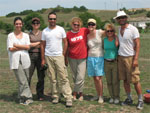
Members of the excavation team, left to right: Veneta Handjiiska, Miglena Vasileva, Giannis Georganas, Daniela Dimtcheva, Eva Tonkova, Milena Tonkova, Thanos Sideris.
|
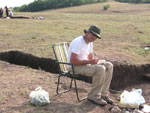
Giannis Georganas writing his calendar.
|
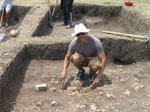
Thanos Sideris cleaning a Neolithic vessel.
|
On the south-eastern sector where a large pit was found –probably used in rituals– with a lot of ashes and scattered pottery of the Classical and Hellenistic periods, continued the research and the collection of the material and the documentation of the shape and size of the pit was completed.
On the north-eastern sector Thanos Sideris continues the research of the Neolithic house. A large part of it was revealed but the boundaries of the fallen walls have not been discovered yet. However, part of a well-made clay floor was uncovered on its south side, which may be identified with the area for sleeping. The excellent quality pottery proves undoubtedly that we are at the cultural layer Karanovo III, which dates from approximately the middle of the 6th millennium BC (7,500 years ago) and belongs in the Neolithic Period.
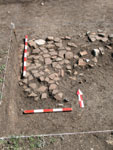
Potsherds of Hellenistic pithos in situ.
|
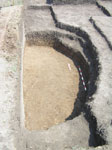
The pit with the ashes and the pottery.
|
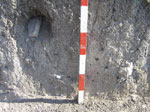
Potsherd of a vessel and traces of coal in the section of the pit that disturbed the Neolithic stratum.
|
Characteristic pear-shaped and cylindrical vessels for drinking were found, as well as an exceptionally well maintained strainer. Among the small findings we find clay beads, flint blades and clay spindle whorls. On the western side the Neolithic stratum has been disrupted by a large pit with ashes and ceramics, mainly of the Hellenistic Period.
Just before the scheduled excavation, a particular interesting finding came to light –a ceramic kiln – whose complete examination will take place in the next excavation period.
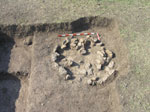
The middle level of the ceramic kiln.
|
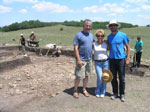
With Vassil Nikolov in front of the floor of the Neolithic house.
|
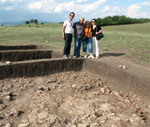
During the visit of Dr. Georgi Nehrizov.
|
The excavation was visited by important members of the Bulgarian archaeological community, among them the former director of the Archaeological Institute, Vassil Nikolov (008), the head of the Archaeological Atlas of Bulgaria, Dr. Georgi Nehrizov, former director of the History Museum of Stara Zagora, Petar Kalcev, the member of the Archaeological Institute Krum Batchvarov and the member of the Museum of Veliko Tarnovo, Nedko Elenski. The visits of the archaeologists and the local authorities incited the interest of the local and national mass media (radio, TV, info-blogs) which presented extended stories with positive comments about the Greek-Bulgarian excavation cooperation.
For FHW:
Thanos Sideris
Chirpan, 19 July 2009
